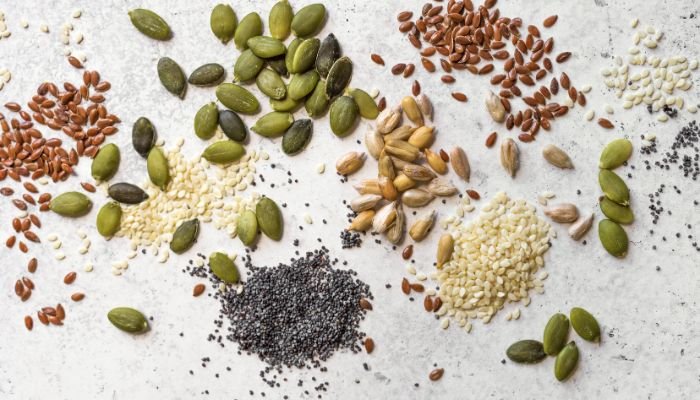Seed Cycling: Can Eating Seeds Restore Your Hormone Balance?
Seed cycling. Heard of it?
It’s a lifestyle practice that aims to help balance your hormones through diet. This practice involves eating specific seeds during different phases of your menstrual cycle to promote hormone balance. While seed cycling could appear as a trend, its roots can actually be traced back to ancient wisdom and holistic practices. And it’s not the only way women are adapting their lifestyle and routines to their menstrual cycle and it probably won’t be the last. Just check out this article: How To Make The Most Of Your Workouts Based On Your Menstrual Cycle.
Today though, we’re taking a deeper look at the concept of seed cycling, exploring both the intriguing anecdotes surrounding its benefits and the scientific evidence supporting or challenging its effectiveness. Let’s get into it.
Understanding hormonal balances
Firstly, to understand why seed cycling is popular, we need to talk about hormones. You probably know this already, our hormones play a pivotal role in our overall well-being, influencing everything from our mood and energy levels to our reproductive health.
Hormonal imbalances – symptoms like irregular periods, mood swings, and acne – can disrupt daily life and have huge impacts on happiness and self-esteem. This is where seed cycling comes into play, aiming to restore hormonal equilibrium through diet.
Seed cycling in practice & recommended seeds for each menstrual phase
Seed cycling is actually very simple in practice, and involves eating specific types of seeds during different phases of the menstrual cycle.
It's worth noting that the recommendations below are based on traditional seed cycling practices, and advocates of seed cycling on Tik Tok have shared personal stories of improved menstrual regularity, reduced PMS symptoms, and enhanced fertility, scientific evidence supporting the specific effects of seed cycling on the menstrual cycle is limited.
Menstruation (Menstrual Phase): Flaxseeds and chia seeds
Lasting from days 1 to 6 of your menstrual cycle, this is the stage when you are likely to experience a number of uncomfortable physical symptoms, namely your 'period'. Aside from the physical effects of blood loss, you may also experience cramps, joint and muscle pain, headaches, bad moods, and low energy levels, all of which may disrupt your usual physical activity.
During this phase, when menstruation occurs and the uterine lining sheds, it's recommended to focus on nutrient-rich seeds to support overall health and replenish nutrient stores. Flaxseeds and chia seeds are often recommended in this stage due to their high content of omega-3 fatty acids, fiber, and essential minerals like calcium and magnesium.
Follicular Phase: Flaxseeds and pumpkin seeds
During this stage of your menstrual cycle — usually from days 7 to 11 — your hormone levels are rising to prepare you for ovulation. This is usually regarded as a more feel-good time.
Flaxseeds are commonly suggested during this phase as they are rich in lignans, which can have estrogen-modulating effects. Pumpkin seeds are also recommended as a great source of zinc, omega-3 fatty acids, and other nutrients that support hormone production and overall reproductive health.
Ovulation: sesame seeds
Occurring anywhere from days 12 to 19 of your menstrual cycle estrogen, and actually testosterone levels spike. This makes you feel more confident, competitive, and more likely to take risks (it also increases your libido to help with that baby-making biz if that's where you're at).
Seed cycling practices suggest that you should support this phase of your menstrual cycle with nutrient-dense seeds such as sesame seeds. Sesame seeds are packed with vitamin E, lignans, and essential fatty acids, which can help support hormone balance and reproductive health.
Luteal Phase: Sunflower seeds
The last stage, lasting from days 20 to 28, causes a smaller spike in estrogen as ovulation and progesterone reach their highest peak as your body prepares the uterus for potential implantation. This is when you are likely to experience PMS symptoms. During the luteal phase due to fluid retention changes, less oxygen is delivered to your muscles, and that contributes to early feelings of fatigue. This might lead to small weight gain, a reduction in sweat production (so it's more difficult to naturally cool yourself), a rise in core body temperature, and your heart having to work slightly harder than normal.
Sunflower seeds and sesame seeds are commonly suggested during this phase. Sunflower seeds are rich in vitamin E, selenium, and essential fatty acids, which can support hormonal balance and overall reproductive health. Sesame seeds, as mentioned earlier, provide similar benefits due to their nutrient profile.
What’s the science behind seed cycling?
While the scientific research on seed cycling for hormone balance is limited, there are studies that shed some light on the potential mechanisms behind its effectiveness. For example, flaxseeds have been shown to exhibit estrogen-modulating effects due to their high lignan content. Some studies suggest that lignans can bind to estrogen receptors, potentially reducing estrogen activity in the body.
Additionally, the omega-3 fatty acids found in flaxseeds and pumpkin seeds have been associated with improved hormone metabolism and reduced inflammation, which may indirectly contribute to hormone balance. Furthermore, zinc, abundant in pumpkin seeds, is crucial for reproductive health and has been linked to improved follicle-stimulating hormone (FSH) levels in women.
The takeaway.
While seed cycling alone may not be a magic fix for everyone, it can be seen as part of a holistic approach to hormonal health. By incorporating nutrient-dense seeds into the diet, individuals could enhance their overall nutrition and potentially support hormone balance indirectly. A well-rounded approach to hormonal wellness may include stress management, regular exercise, adequate sleep, and a balanced diet rich in fruits, vegetables, whole grains, lean proteins, and healthy fats.
So will you give seed cycling a go? Let us know in the comments!

